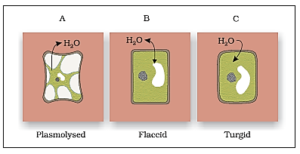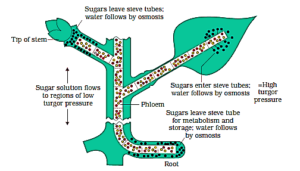1. What are the factors affecting the rate of diffusion?
Solution:
Factors affecting the rate of diffusion are:
Gradient of concentration
The permeability of the membrane separating them
Temperature
Pressure
2. What are porins? What role do they play in diffusion?
Solution:
The porins are proteins that form large pores in the outer membranes of the plastids, mitochondria and some bacteria. The large pores allow molecules up to the size of small proteins to pass through. Hence, they promote diffusion.
3. Describe the role played by protein pumps during active transport in plants.
Solution:
Protein pumps use energy to carry substances across the cell membrane. These protein pumps take the substance from a region of lower concentration to the region of higher concentration. They take part in transportation with the help of energy against the concentration gradient, wherein the energy is supplied by ATP. The protein pumps, upon getting activated with energy picks up solute particles from the outside to transfer it to the inside of the cytoplasm. When all the protein pumps are getting used, transport rate reaches its maximum.
Active transport is the transport of ions across the membrane of plants through these protein pumps involving energy.
4. Explain why pure water has the maximum water potential.
Solution:
Pure water has the maximum water potential because they have the kinetic energy of their own and they remain in constant random motion. The water molecules in pure water possess maximum kinetic energy which decreases with addition of solutes, subsequently free energy of the water molecules gets decreased. Hence, pure water is said to have maximum water potential.
5. Differentiate between the following:
(a) Diffusion and Osmosis
(b) Transpiration and Evaporation
(c) Osmotic Pressure and Osmotic Potential
(d) Imbibition and Diffusion
(e) Apoplast and Symplast pathways of movement of water in plants
(f) Guttation and Transpiration
Solution:
a) Diffusion and Osmosis
Diffusion
Osmosis
It is passive transport in which movement of substance takes place from the region of higher concentration to lower concentration.
Osmosis is a special type of diffusion in which substances get separated through a semi-permeable membrane
Occurs in any medium
Occurs only in the liquid medium
Does not require semi-permeable membrane
Semi-permeable membrane required
No role of turgor pressure
It faces resistance by turgor pressure of the system
b) Transpiration and Evaporation
Transpiration
Evaporation
Takes place in plants
Occurs in any free surface
It is a physiological process
It is a physical process
Slower phenomena
It is a fast process comparatively
Takes place at the exposed plant surface
Takes place at the surface of non-living objects
Affected by pH , CO2 and hormones
Evaporation is not affected by pH , CO2and hormones
c) Osmotic Pressure and Osmotic Potential
Osmotic pressure
Osmotic potential
It is developed by the entry of water into an osmotic system
Osmotic potential is lowering of free energy of water in a system due to the presence of solute particles.
It is developed only in a confined system
It is present in both confined and open systems.
Its value is positive and expressed in bars
Its value is negative and expressed in bars
d) Imbibition and Diffusion
Imbibition
Diffusion
Absorption of water by solid particles without forming solution is called imbibition
Movement of substance from a region of higher concentration to the part of lower concentration
It is faster
It is slower comparitively
Heat is liberated during imbibition
Heat is not liberated during diffusion
Adsorbent present
Adsorbent absent
Volume changes, as the imbibant swells up
No change in the volume of the substance
e) Apoplast and Symplast pathways of movement of water in plants
Apoplast
Symplast
Comprises of nonliving parts of body such as cell walls and intercellular spaces
It consists of living parts of a plant body.
Faster comparitively
It is slower
Slight resistance offered in the movement of water
Some resistance occurs in the water movement through Symplast
The metabolic state of the roots has no impact on the apoplast pathway
The metabolic state of the roots have a direct influence on symplast pathway
f) Guttation and Transpiration
Guttation
Transpiration
Loss of liquid droplets from the plant
It is the loss of water in the plant in the form of vapour.
Takes place through water pores
Takes place through, lenticels, stomata and epidermal cells.
During guttation water pore is always kept open.
Stomata may be closed or open during transpiration
Takes place during humid periods.
Takes place during dry periods.
6. Briefly describe water potential. What are the factors affecting it?
Solution:
Water potential is the tendency of the water to move from one area to other due to osmosis, gravity and mechanical pressure. In other words, it is the difference in the free energy or chemical potential per unit molal volume of water in a system and that of pure water, at the same pressure and temperature. It can be estimated in units of pressure. At a standard temperature and pressure, pure water is defined as possessing a 0 water potential. When solutes are added to water, potential lowers and increase in pressure, increases potential.
Factors affecting water potential:
Solute potential
Pressure potential
Matric potential
Pressure
Temperature
Gain/loss of water
7. What happens when a pressure greater than the atmospheric pressure is applied to pure water or a solution?
Solution:
When a pressure greater than the atmospheric pressure is applied to pure water or a solution, its water potential increases.
8. (a) With the help of well-labelled diagrams, describe the process of plasmolysis in plants, giving appropriate examples.
(b) Explain what will happen to a plant cell if it is kept in a solution having higher water potential.
Solution:
a) When water moves out of the cell and the cell membrane of a plant, cell shrinks away from its cell wall and plasmolysis of the cell takes place. When the cell is placed in a hypertonic solution to the protoplasm (as seen in figure A), water moves out. Water is first lost from the cytoplasm and then from the vacuole. This causes shrinkage of the cell and cell is said to be plasmolysed.
b) When plant cell is kept in a solution with higher water potential plant cell absorbs water by endosmosis and the cell becomes turgid or swollen (as observed in figure C). The swollen protoplast develops a wall pressure that becomes equivalent to the water potential of the system thereby resulting in the endosmosis to stop.

9. How is the mycorrhizal association helpful in absorption of water and minerals in plants?
Solution:
Hyphae of mycorrhiza have very large surface area which helps in absorbing water and minerals. Thus the association of plants with Mycorrhiza helps in absorption of water and minerals in plants.
10. What role does root pressure play in water movement in plants?
Solution:
In herbaceous plants, Root pressure helps upward movement of plants.
11. Describe transpiration pull model of water transport in plants. What are the factors influencing transpiration? How is it useful to plants?
Solution:
Transpiration pull helps water rise in tall trees which is created by loss of water or the process of transpiration from the pores of stomata of leaves which is known as cohesion-tension model of water transport. The water that is lost during day time through the process of transpiration results in the epidermal cells and guard cells to turn
flaccid. In turn, these take water from the xylem creating a negative pressure or tension in the xylem vessels from the surface of the leaves to root tips, through the stem. Subsequently, water in the xylem gets pulled as a single column from the stem. The adhesion and cohesion forces of the water molecules and cell walls of the xylem vessels restrict the splitting of the water column.
Factors affecting transpiration pull are
Temperature
Relative humidity
Light
Wind
Plant factors – number and distribution of stomata, canopy structure, water status of plants, number of open stomata
Importance of transpiration pull
It has a cooling effect on plants
Transpiration pull exerts ascent of sap which helps in the distribution of mineral salts.
It helps in retaining shape and structure by keeping the cells turgid.
Transpiration helps in the removal of excess water absorbed by the plants.
Provides water for photosynthesis
12. Discuss the factors responsible for ascent of xylem sap in plants.
Solution:
Factors responsible for ascent of xylem sap in plants are as follows:
Cohesion: Mutual attraction between water molecules.
Adhesion: Attraction of water molecules to the polar surface.
Root pressure: is a positive pressure which pushes sap from below because of active absorption by roots.
Surface tension:attraction of water molecules to each other in the liquid phase more than water in gas phase
Transportation Pull: transpiration in aerial regions draws the xylem sap under negative pressure which withdraws water continuously.
13. What essential role does the root endodermis play during mineral absorption in plants?
Solution:
Because of deposition of lignin and suberin, endodermal cells have thickening in their radial walls. This prevents apoplastic movement of water and minerals, hence allowing only symplastic movement of minerals in plants.
14. Explain why xylem transport is unidirectional and phloem transport bi-directional.
Solution:
Water moves only in the upward direction when absorbed by roots through the xylem. Hence water transport is unidirectional. Food is transported by the phloem tissue. Food is synthesized in leaves and required by both roots and shoot system thus phloem sap moves upwards as well as downwards making food transport bidirectional so that it can reach other plant parts.
15. Explain pressure flow hypothesis of translocation of sugars in plants.
Solution:
Food is continuously prepared in plants in the mesophyll cells of the leaves in the form of glucose. The food that is prepared is converted into sucrose and is then passed to the source cells located in the phloem. Water contained in the xylem vessels moves to the nearest phloem causing the hydrostatic pressure in the phloem to rise. This causes the movement of sucrose via the sieve cells of the phloem. The sucrose that is already found in the sink region converts into starch or cellulose causing a reduction in the hydrostatic pressure in the sink cells. Subsequently, the difference in pressure that is created between the source and the sink cells permits the sugars to be translocated to the latter from the former.





